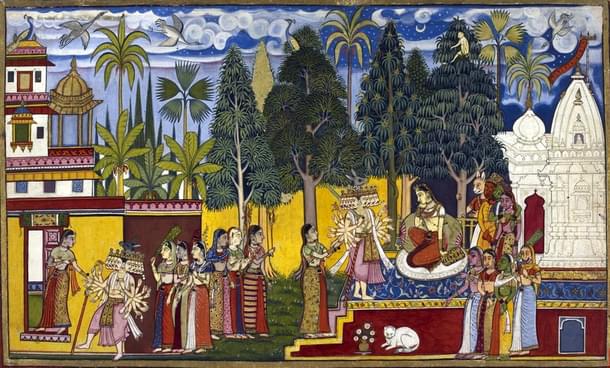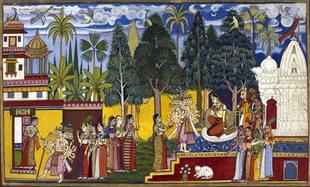Culture
Hinduism: Pre-Modern, Modern, Postmodern, Or Post-Postmodern?
Devdutt Pattanaik
Dec 31, 2015, 10:32 PM | Updated Feb 12, 2016, 05:31 PM IST
Save & read from anywhere!
Bookmark stories for easy access on any device or the Swarajya app.


The idea of subjective truth discomforts most people. They prefer objective truth. This is because of our conditioning, resulting from ‘scientific’ education. In objective truth, the truth exists outside us. We play no role in the truth. This structure, of excluding individual views, from the truth, is Abrahamic. God, and Truth, is located outside humanity. This became ‘modern’ thought as against ‘pre-modern’ thought that was located on fear. For the scientist, all things pre-modern are superstition.
For the theist, religion is modern. Hence the yearning to show that religion is based on ‘scientific’ principles. But in the late 20th century, the idea of postmodernism came in, which valued subjectivity and its scholars revealed how, especially in the Humanities, all objective theories were actually outcomes of subjective structures. Marxism, for example, was found to be aligned to the Abrahamic narrative of Eden (all was wonderful in the distant past)—then came the Original Sin (inequality) and one day there will be Apocalypse and Return (revolution that will restore primary equality).
A similar structure is followed by many in the extreme Hindu right wing, often goaded by American passport wielding PIO cult leaders. Thus they speak of Eden (Vedic civilisation), then the Original Sin (Islamic and colonial rule) and the day of Apocalypse and Return (Hindutva?).
Let us trace the nature of Hinduism: is it pre-modern (superstitious subjectivity), modern (scientific objectivity), postmodern (acceptable subjectivity), or post-postmodern (inter-subjectivity)…or something more.
In the 17th century, Reason entered the life of the European. It was a rediscovery of what the Greeks had propagated. Rational thinking became the method to overpower the superstitions of the Church. This mindset came to be known as ‘modern’ thinking as it was based on rationality. They considered those who did not possess rational thinking to be ‘pre-modern’. For scientists, religious thinkers were so.
By the 18th century, following the Reformation of the Church, an uneasy peace was established between the believers of science and the believers in religion. It was this mindset that the Europeans carried with them when they came to dominate the Indian subcontinent.
Both, the religious and rational thinking of Europe, had one thing in common – a faith in rules and in the dogma of absolute truth and a belief in one life. Ideas of relativism discomforted them. In India, they found people who had no single common belief or rule and who believed in rebirth! They naturally concluded that India was pre-modern. To make India modern was the white man’s burden. That is why the Sahib introduced scientific thinking and English education in India.
In hindsight, one realizes that the 18th century European was not equipped with the intellectual wherewithal and the philosophical vocabulary to explain Indian thought. Limited by his language, unable to understand and appreciate Indian thought, he assumed Indians were irrational, hence inferior.
In the 19th century, Indians started getting educated in the Western way and they saw how Indian thought was being perceived by the English masters. This fuelled an inferiority complex. They argued passionately. Some became apologetic and others defensive. And all efforts were made to present the allegedly pre-modern as modern. This led to the Hindu Renaissance. While the good part was that it helped force Indians to question some practices that dehumanized fellow humans (like burning of widows, child marriage and untouchability), the tragic part was that it also led to greater focus on lofty ideals of Sanskrit Upanishads and a distancing from folk beliefs and customs.
It’s an activity that still goes on in the 21st century as people go out of their way to logically explain the rules of religion. There is still pressure to make everything from meditation to yoga scientific. What is rational is real, goes the maxim, hence the disdain, even hostility, to the word ‘myth’ and ‘mythology’.
Unknown to most people, the 20th century saw academic circles challenge modern thought itself. They discovered rules were made with prejudice. Whose prejudice? The rule maker’s prejudice! The rule maker was not objective. He could not be objective. He created rules to benefit him and his. A butcher would never make rules that promoted a vegetarian lifestyle. And a vegetarian would never make rules that would celebrate meat eating lifestyles. Right and wrong were matters of perception. All judgments thus depend on discourse – the stories that shape our mind. Those who argued this were the ‘post-modern’ thinkers.
Maybe Indian thought is neither pre-modern as the British thought it was, nor is it modern as rationalists would like it to be. Maybe it is post-modern, subjective, relative and plural. Anything goes. That is why, perhaps, Indians worship animals and plants and humans. Some groups prefer one thought and others prefer another thought. All groups, with opposing thoughts, argue but coexist. This is tolerance. The acceptance of all sides and all points of view. Different rules for different people. Different rules depending on the context.
But this postmodern view of Indian thought has a problem. It can easily lead to the conclusion that Indians are opportunists, who change their mind as per will and convenience. Many academicians have taken the route of challenging traditional Indian thought using the postmodern approach. Thus Ram, they claim, becomes God only because it was an imposition of patriarchal Brahminical hegemony. They challenge the divinity of Krishna and say that the Bhagavad Gita with its line ‘focus on tasks not results’ is a creation of the ruling class to keep people oppressed. They argue one can read the Ramayana with Ravan as a hero and the Mahabharata with the Pandavas as the villains. It is just a point of view. And this leads artists to imagine Shiva with goggles and Ganesha with jeans and the Goddess holding a machine gun. In the post-modern world, nothing is sacred, everything can be profane. It is just about the chosen dominant discourse. One can twist and turn things at will. Mix-and-match becomes the name of the game.
And this becomes distasteful for those who have always celebrated Indian thought. They know it is not pre-modern – there is a logic in it. They know it is not modern – it defies the logic of rules and ethics and morality imposed by the West. And it is certainly not post-modern that turns it into a random and shape-shifting quilt of convenience, where nothing matters. So what is it then?
Perhaps Indian thought is best seen in the post-postmodern light. It is a combination of contextual and a-contextual. Every idea needs to be located in a particular space or time (the contextual), otherwise they make no sense. Thus Ram belongs to Ramayana and Krishna belongs to Mahabharata; one cannot simply mix and match the two. There is also a consistent pattern between the contexts (the a-contextual). This is the idea of dharma, the notion that humans can transcend animal instincts and overpower the law of the jungle, or matsya nyaya. This theme is prevalent in both the epics. In the Ramayana, Ravan behaves like an alpha male while in Mahabharata, the Kauravas behave like alpha males, clinging to other people’s wives in one case and other people’s land in the other. Ram and Krishna are different from each other – one upholds rules and one breaks them. Yet, they are similar to each other – they uphold dharma. Thus there is a pattern beneath the apparent cacophony. It is this consistency of theme despite the apparent randomness that makes it “post-postmodern”.
However, post-postmodern speaks of inter-subjectivity and often assumes subjectivity as fixed. Thus there is my truth and your truth and I may respect your truth and you may respect my truth. But there is no concept of expanding truths: not of being influenced by other truths, but of expanding our own frameworks of understanding to accommodate myriad subjectivities around us.
This idea is embedded in Hindu mythology, where divinity is located in everyone (jiva-atma) and everyone is located within divinity (param-atma). We can acknowledge, appreciate, accommodate and even assimilate each other’s truth to expand our mind. Expanding the mind gives us the concept of brah-mana. Including various divided truth gives us the concept of bhaga-vana. It helps us understand why God in Hinduism is associated with infinity (ananta) who lords over the limitation of materiality (vasudeva). This is not Brahminism, as many American Indologists would conclude. Brahminism is but one truth. Sanatana dharma (timeless path) is about constantly expanding the mind, with the constantly expanding cosmos, not a narrow political and economic ideology.
(Based on an article by the author first published in Sunday Mid-day in 2010)
The author is a mythologist, with 30 books and 600 columns to his credit that explain the relevance of sacred stories, symbols and rituals in modern times. For more about him, visit devdutt.com)
Devdutt Pattanaik writes on relevance of mythology in modern times. To know more visit devdutt.com





